

Josh Nevett
2025 Bentley Bentayga review
5 Days Ago
An extraordinarily complete package that ticks all the boxes from design, practicality, tech and performance and for a reasonable price.
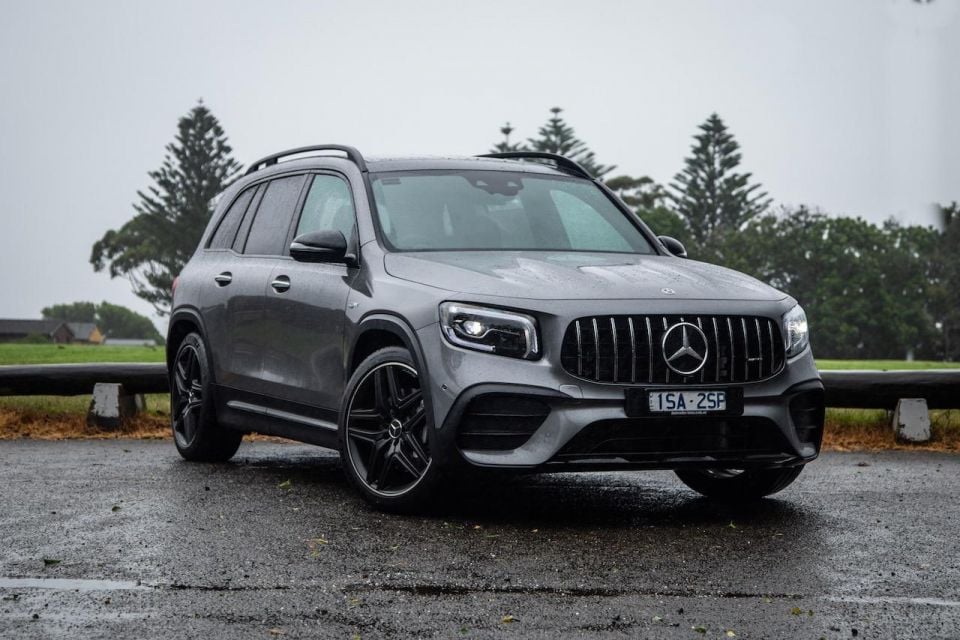


Senior Road Tester

Senior Road Tester


Senior Road Tester

Senior Road Tester
Where expert car reviews meet expert car buying – CarExpert gives you trusted advice, personalised service and real savings on your next new car.
Every time I tell myself performance SUVs like the Mercedes-AMG GLB35 are a truly daft idea and can’t be justified on any rational basis, I end up doing a total backflip every time I get behind the wheel of one.
After all, SUVs with room for seven (albeit two young kids) should be about practical family hauling first and foremost, shouldn’t they?
Not according to AMG, at least. The go-fast division of Mercedes-Benz has a different view of the family chariot, and one that is shared equally amongst all European luxury carmakers – German and British alike.
And, frankly, once you’ve driven a souped-up SUV in this segment, it’s hard not to be swayed by one of three things; the extra performance, better exhaust note and beefed up looks – all of which are bursting out in the Mercedes-AMG GLB35.

If you do happen to have just cause, or indeed, an ultimatum to finally ditch the sports car or any of the punchy euro sedans for some hi-riding sensibility machine at the behest of your better half, then why shouldn’t you be able to have your cake and eat it, too.
And, let’s not forget the overwhelming popularity of AMG models of all shapes and sizes in Australia – one in every five Benzes sold here is an AMG model.
We’ve always been a flourishing market for anything with a performance bent regardless of the badge or size of vehicle, and nothing has changed in that regard.
SUVs have only made the market more lucrative with significantly more sales and fatter margins to boot.

The AMG GLB35 starts at $88,535 (plus on-roads), commanding a wallet-busting premium over the entry-level Mercedes-Benz GLB200 priced from $59,900 excluding on-roads, and a sizeable bump in price from the mid-spec $73,900 GLB250 4Matic.
Still, the Mercedes-AMG GLB 35 is least expensive against its closest rivals. Audi has the slightly smaller, yet more powerful RSQ3 and sportier RSQ3 Sportback twin-pack starting from $89,900 and $92,900 (before on-road costs), respectively.
BMW seduces family-friendly petrol-heads with its slightly larger X3 M40i xDrive, which packs more punch under the bonnet but comes with a significantly higher price tag of $113,900 plus on roads. You can also have the smaller and less-practical X2 in M35i xDrive guise – which has similar performance specs to the GLB35 – from $73,900 list.

British stalwart Jaguar also plays in this space with its F-Pace P400 SE from $97,400 before on-road costs and is two-tenths slower from 0-100km/h despite its price premium, though it has a greater luggage capacity than the Benz.
Our Mountain Grey Metallic GLB35 tester (the paint is a $1490 option) was also equipped with two of three options packs available, including the Vision Package ($1190, multibeam LED headlights with adaptive high beam, panoramic sunroof, 360-degree camera), Driving Assistance Package ($1990, adaptive cruise control with lane change assist) and a set of very cool 20-inch matte black alloy wheels ($790).
All up, the car you see as-tested is worth $93,995 plus on-road costs – or a little over $100,000 drive-away.

Even the entry-level GLB200 boasts an extensive array of features and creature comforts including highlights such as LED headlights, wireless phone charging, ambient lighting, keyless entry and start, 19-inch alloy wheels, and the MBUX infotainment system with dual 10.25-inch high-definition displays with satellite navigation.
There’s also auto dimming mirrors and a nine-speaker sound system with DAB+ radio as standard. The GLB250 4Matic builds on this further with comfort seats, heated and cooled front seats with memory and a panoramic glass sunroof.


As the range-topper, the AMG GLB35 specification brings with it a host of AMG-specific kit such as 20-inch alloy wheels, the AMG Night package (effectively a black pack), an AMG Performance steering wheel wrapped in Nappa leather, adaptive damping, AMG-specific body kit and comfort sports seats in Lugano leather.
The cabin boasts ‘carbon structure’ trim, as well as a host of other AMG-specific goodies including illuminated AMG door sill panels, a sports exhaust system, high-performance brakes, a Panamericana front grille with AMG lettering, speed-sensitive power steering and an AMG-tuned eight-speed dual-clutch transmission with dynamic drive modes.
And those are just the highlights – there’s also a range of the latest active safety systems standard across the range.

Specifically, the GLB35 hasn’t been crash-tested but the entry GLB200 was tested by Euro NCAP in 2019 and awarded five stars, which applies to Australian-delivered GLB200 and GLB250 variants only.
Those scores included a 92 per cent for adult occupant protection, an 88 per cent child occupant rating, 78 per cent for vulnerable road user safety, and a 76 per cent for safety assist.
Standard safety features across the range include autonomous emergency braking (city, interurban and vulnerable road user) as well as lane-keep assist with lane departure warning, and blind spot monitoring.
There are also nine airbags including dual front, side for first and second row outboard seats, and side curtain for all three rows, as well as a driver’s knee airbag.
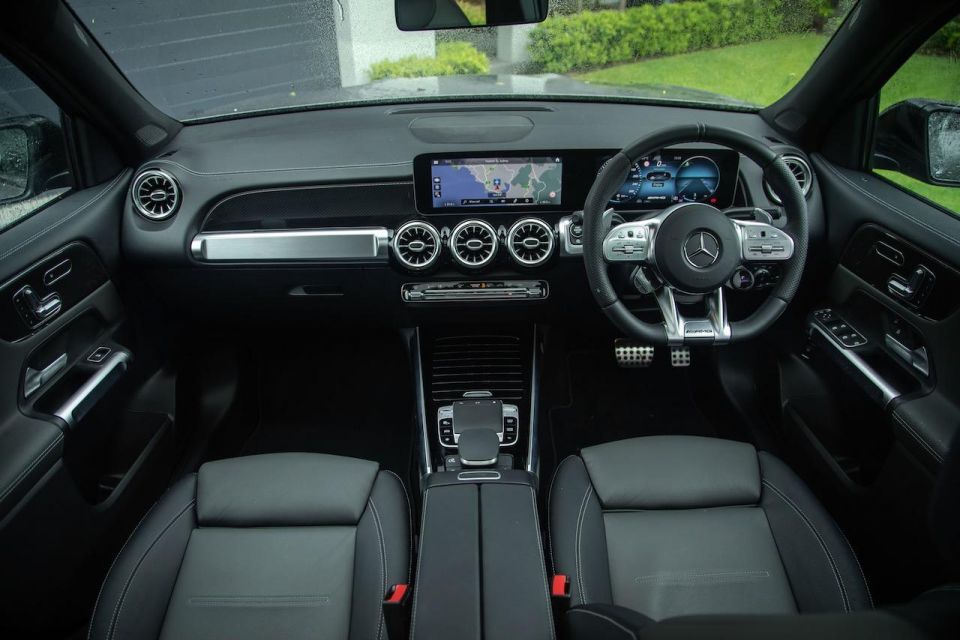
This is where Mercedes-Benz shines brightest across its entire range of cars and SUVs – with interior spaces that not only ooze luxury but also present the latest in cutting-edge technology.
Ordinarily, I’m a big fan of burgundy-coloured upholstery contrasting a grey interior but there’s plenty of shiny bling throughout the entire cabin to make it an interesting place to sit, despite the more subdued two-tone grey leather fit out in this tester.
Front and centre, though, are the high-definition twin screens covering infotainment and the driver’s display better than any other make/model in the segment in my view, offering plenty of configurability and functionality for first time users thanks to MBUX – the latest Mercedes-Benz infotainment system.




The flat-bottom, AMG-badged steering wheel might be busy with a vast array of buttons, toggle switches and scrollers, but it’s all wonderfully intuitive and made easier by the haptic scroll feature on both sides. Even the perforated leather grip sections feel especially tactile for ultimate grip in the bends.
I’m always drawn to the aviation-inspired turbine air vents in almost any Benz these days – not just the avantgarde styling but the practicality and size of the air flow mechanism itself.
There’s also the spectacular ambient light show that has become another Benz trademark and something I initially found a bit kitsch, but these days loving the sheer vibrancy of the purple and blue shades while on a Saturday night take-away mission while catching up on our most recent podcast.




There’s no wireless Apple CarPlay or Android Auto for GLB, but there are no less than seven USB-C ports throughout the cabin – including two for third-row passengers – just remember to ditch your USB-A cords or you’ll have to resign to Bluetooth.
My Colleague Paul Maric has already called out the voice recognition system in the GLB in his review of the GLB250, but as one that’s addicted to CarPlay, I’ll have to take his word for it.
You’ll also find a few short-cut buttons either side of a relatively redundant track pad apparatus (nowhere near as bad as the Lexus version) complete with hand rest. Awful waste of space in my view given the large touchscreen at hand.
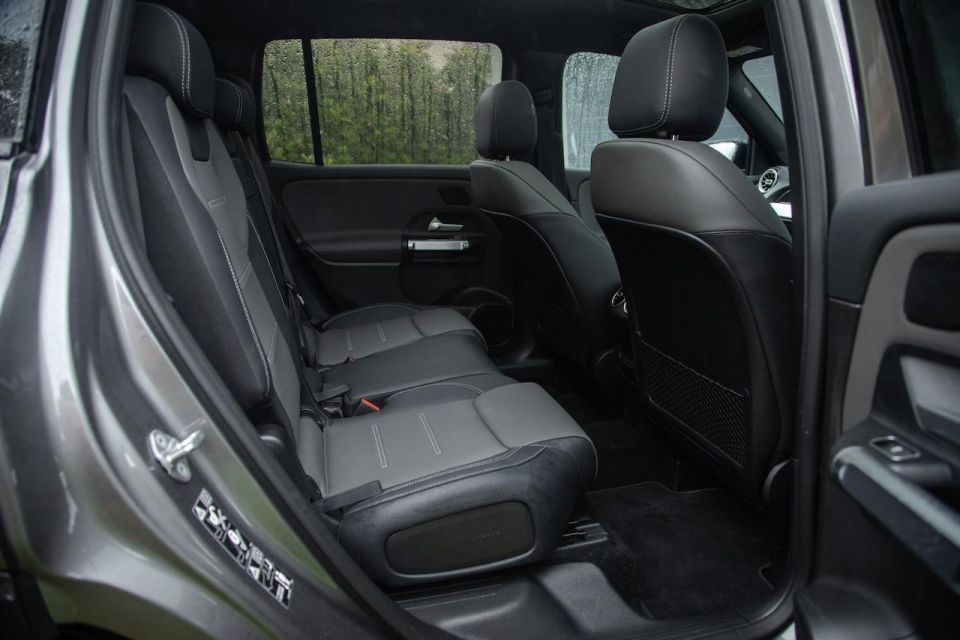



Storage is another big winner in the GLB35 with more than a generous number of bins and cubbyholes in the centre console alone, let alone the door bins and a surprisingly useable glovebox.
It’s a similar story with the rear seating arrangement, too. The second-row seats are on rails, can be slid forward or back, and when set to the latter it opens up extensive rear legroom with the transmission tunnel hump relatively low making middle-seat passenger journeys more comfortable. However, ditching the middle person in second row means a wide centre armrest with storage and hideaway cup holders.
That said, for kids in the third row to gain any sort of reasonable legroom – the second row will need to be moved almost all the way forward. And, if you do have a full carload of passengers don’t expect to carry much more than a few grocery bags, whereas if used a five-seater there’s up to 700 litres of boot space with the seats in that most forward position. place, which expands to 1680 litres when all rear seats folded – dead flat.




For surfers, there’s room for a seven-foot board without impeding the front cockpit or longer again if you don’t mind the intrusion.
You’ll also get a 29-inch medium-frame MTB bike in there, too, as tested. But then, I can also manage that in a GLA with a bit more fiddling, if need be.
Equally, the GLB offers a nice wide aperture and conveniently low floor height for easy loading of heavier or awkwardly-shaped items, and there’s a tad more space under the floor behind the third row, as well as clever storage of the cargo blind.
There really is a ton of space inside the GLB35 for such a modestly-sized SUV thanks to clever architecture. Tick.

The Mercedes-AMG GLB35 uses the same ‘M260’ 2.0-litre four-cylinder turbocharged petrol engine as its less-powerful GLB250 sibling (165kW/350Nm), only in this AMG guise it’s tuned to deliver a more serious 225kW of power at 5800rpm and 400Nm of torque from 3000-4000rpm.
Drive is channelled to the black stuff via an eight-speed AMG-enhanced dual-clutch automatic transmission and 4Matic variable all-wheel drive system. Performance from zero to 100km/h is a claimed 5.2 seconds.
Referencing those rivals mentioned earlier, the Audi RSQ3 uses a 2.5-litre five-cylinder powerplant making a hefty 294kW and 480Nm through a seven-speed dual-clutch gearbox with a claimed 0-100km/h sprint time of 4.5 seconds.

Where expert car reviews meet expert car buying – CarExpert gives you trusted advice, personalised service and real savings on your next new car.
BMW’s X3 M40i employs a 3.0-litre in-line turbocharged six-cylinder petrol motor mated to an eight-speed auto developing 265kW and 500Nm to all four wheels – good enough for a 4.8-second 0-100km/h dash.
The Jaguar F-Pace P400 R-Dynamic SE sizes up with a turbocharged 3.0-litre inline six petrol engine with mild-hybrid technology generating 294kW and 550Nm, put through an eight-speed automatic transmission to both axles with a claimed time of 5.4 seconds for the zero to 100km/h run.
As with all performance-based turbocharged engines, you’ll need to fill the GLB35 with premium fuel – 95RON at the very least – and while the factory fuel consumption claim is 8.3L/100km on a combined cycle, we were averaging 11.7L/100km on predominantly urban roads.
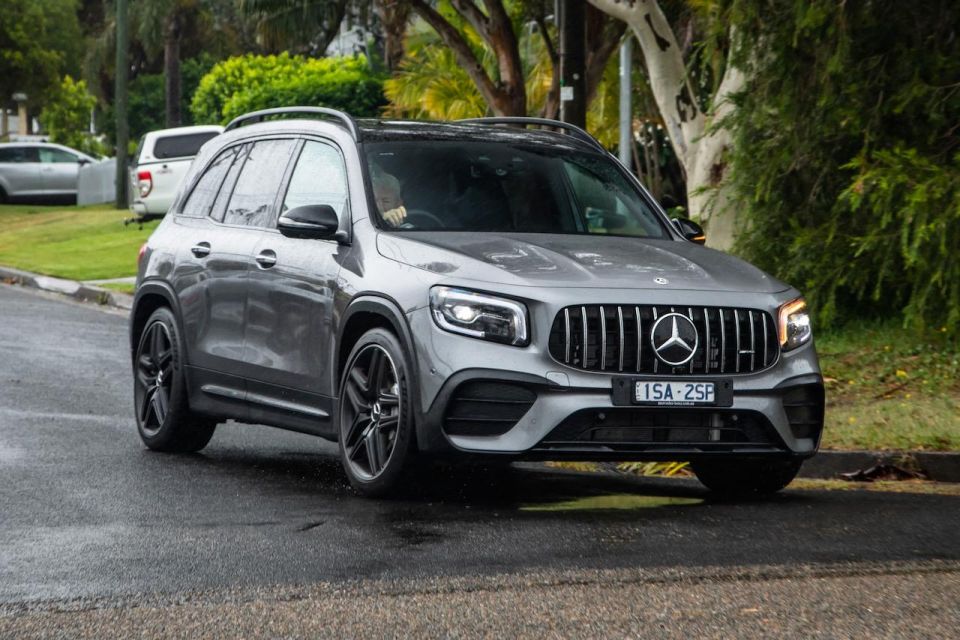
Granted, the GLB 35 isn’t a full-fledged AMG product with hand-built bits from Affalterbach, but it does perform mighty well for what is a practical luxury SUV.
Make no mistake, this is a big step up in all-round performance from its more humble GLB250 stablemate. It definitely feels like a honed go-fast SUV from the moment you tuck into a corner at a decent clip.
To tell you the truth, I wasn’t even expecting this level of straight-line-go from something so boxy and utilitarian as the GLB. In fact, despite its high-riding profile, it actually feels more like a hot hatch than any SUV.
There’s minimal off-the-line turbo lag before pulling hard in the mid-range – and it doesn’t seem to let up before you run of road or exceed the speed limit. The AMG-tweaked dual-clutch auto is a cracker for its ability to rifle through the gears seamlessly but with a suitable sense of urgency and theatrics – especially in Sport mode on the throttle-blipping downshifts.

But, even when you’re gridlocked and creeping forward at a snail’s pace, the shifting is also characteristically smooth and satisfying with none of that jerkiness that you so often here about with this type of gearbox. Even the idle start/stop system is seamless – I know, because I haven’t yet felt the need to extinguish it – something that I normally do on a mandatory basis.
The exhaust note could be better, but it’s a mixture of natural engine noise and the man-made stuff that’s piped into the cabin for your listening pleasure. It’s more common than not these days and not worth a complaint given the multitude of regulations carmakers need to comply with.
Straight-line speed is one thing – satisfying enough, for sure. But where the GLB35 surprises most is in the handling and ride departments. Yep, every time I felt compelled to attack a corner with proper commitment I expected the reaction to be at least some body roll – only, there isn’t any.
At least, nothing discernible. Perhaps a race track might expose some weaknesses in that regard, but that kind of test is totally irrelevant for the GLB.

Some of that is down the AMG-tuned speed-sensitive variable power steering that offers good weighting and a natural feel with a quick response. The rest is down the sheer level of grip (especially in the wet), thanks to AMG’s calibration of the Benz all-wheel drive system which makes the GLB35 feel nicely balanced.
Body control is simply outstanding for a vehicle with these proportions and yet, while the ride is clearly less forgiving than the GLB250, there’s still sufficient suppleness in the suspension to deal with all manner of bumps and broken roads.
It’s simply better controlled over those surfaces and largely the result of the AMG-tuned adaptive damping system on board. It’s hard to see where this could be further improved.
And, that’s in more focused drive modes. It’s properly comfortable in the standard setting. Benz has really nailed this compromise over the last few years, whereas prior to that period, AMG seemed only to know three settings; hard, harder and rock hard.
Behind the 20-inch alloys, the 350mm front and 330mm rear brake discs didn’t really look up the task of stopping this 1875kg SUV, but don’t be fooled, braking power is impressive with a confident pedal feel that inspires a good degree on confidence.

As the first luxury car brand to offer a five-year, unlimited-kilometre warranty with five years of roadside assist, it’s a strong argument for new car buyers in this space.
BMW and Audi still only offer three years, while Jaguar Land Rover have a five-year warranty special in place.
There are also long service intervals of 25,000km or 12 months (whichever comes first). Moreover, owners can purchase a three-year/75,000km capped-price service plan for $2750.
A fourth and fifth year can be purchased for a further $750 and $1800 respectively, given they are major services.
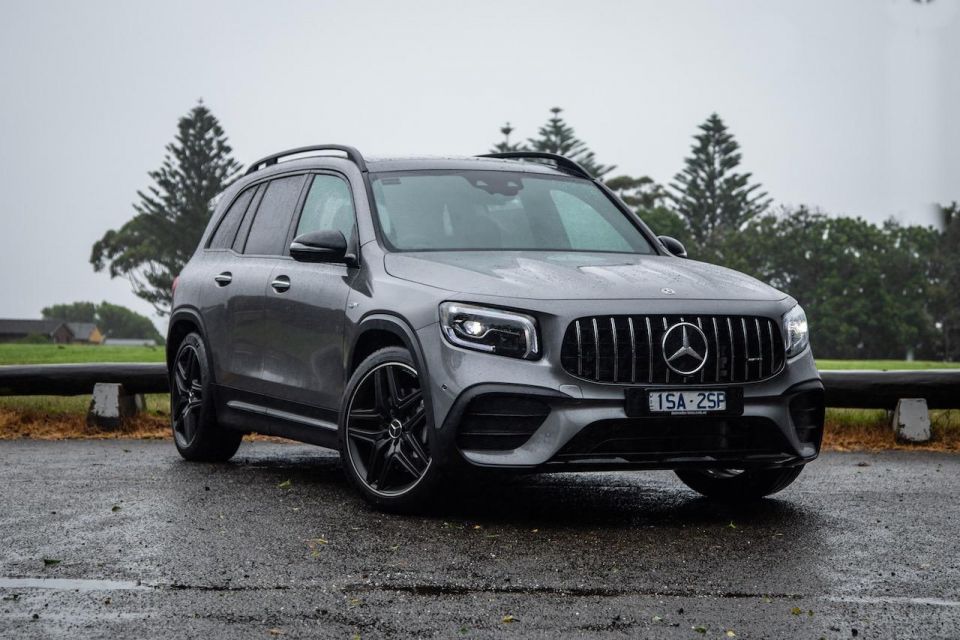
If you still don’t buy into the idea of a performance-SUV with a luxury badge on the bonnet, but call yourself an enthusiast with a move to a high-riding family hauler on the cards, I implore you to put the Mercedes-AMG GLB35 at the top of your shortlist.
The AMG body kit makes this boxy SUV look somehow ‘cool’ in a military-kind-of-way but with outstanding corner-carving ability and serious levels of go on tap at the same time.
Inside, you’re treated to a comfortable and tech-laden cockpit with some of the best widescreen displays in the business. It’s also wonderfully practical but never feels too big or unwieldy in tight spots.
Sure, you can save a packet buying the GLB250, and even more with the GLB200, but where’s the fun in those?

Click the images for the full gallery
Where expert car reviews meet expert car buying – CarExpert gives you trusted advice, personalised service and real savings on your next new car.


Josh Nevett
5 Days Ago


Andrew Maclean
5 Days Ago


Shane O'Donoghue
4 Days Ago


Anthony Crawford
3 Days Ago


Matt Campbell
2 Days Ago


James Wong
1 Day Ago